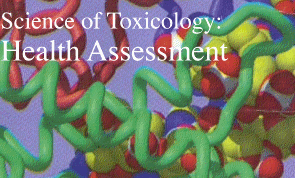Casarett and Doull's Toxicology, Fifth Ed. , (96) |
||
CALENDAR |
||||||||
Causation: General versus specific causation--what is the difference, when is each used. Key steps in assessing each.
Indoor Air at home: Where more time is spent than anywhere else, but is the least regulated. Implications for high risk groups: pregnant women, children, the elderly and those with pre existing illnesses. Homes have never been more air tight and built with more synthetic materials. What too look out for. [see also, Toxicology & the Home]
EMF (Electromagnetic frequency) radiation from cell phones and other sources: updated comprehensive review of recent studies, neurological effects, (EHP, 112: 1741-1754).
Terminology and acronyms of Toxicology: What they are, what they mean and how are they used and how they should not be used.
Simple Statistics: explanation of basic statistical concepts and tests--l analysis of chemical toxicity; avoiding the traps and confusion.
Chemical Mixtures: 2 + 2 > 4. Exposure to multiple endocrine disruptor chemicals, each at concentrations well below the No Observed Effects Level (NOEL), combine to stimulate endocrine receptors significantly. Implications for pregnant women and other high risk groups exposed to ambient levels of these chemicals [EHP110:917-921].
Childhood vaccines containing Thimersol, a preservative containing ethylmercury. Significantly higher amounts of mercury in the brain than previously calculated: problems with using methymercury measurments as standard for ethyl mercury. [Environ. Health Persp.113:1015-1021]
Phthalates: ubiquitous in plastics, cosmetics and other home products. Mechanism of toxicity on hormonal regulation--what this means for exposed populations, especially in utero and in children [for clinical effects see also Toxicology & Medicine, In Depth].

References & Links
Indoor Air Pollution, Asthma and other Respiratory Problems, see NAS: www.nap.edu/books/0309064961/html/
Endocrine Disruptor Chemicals (EDCs): products commonly found in [see examples; Public Health]
Hurrican katrina: Toxic aftermath and long term toxic consequences. Characterization of the types and amounts of chemicals at area Superfund sites, hazatdous waste dumps, chemical plants. How chemicals are spread by the flood, how they interact with each other and the sediment, and whether they will persist. Key toxics released: how many are among ATSDR's 'Top 20' hazardous substances (of the 275 chemicals that it assesses at Superfund sites, ATSDR identifies 20 most important as community hazards);the risks these chemicals pose to surrounding communities. Airborne risks once the toxic muck begins to dry; persistence in the environment, and bio-accumulation up the marine and land food chain. Read the upcoming review and analysis by Thomas F. Schrager, Ph.D., a toxicologist with twenty years experience working with toxic chemicals in the New Orleans area.

Risk Assessment is another type of causation: predicting whether an exposure, usually in a population rather than a single individual, will increase the risk of developing some adverse health effect, without necessarily determining whether such health effect actually occurs. Risk means that all such exposed individuals are more likely to develop an adverse effect, but it does not mean that any particular individual will or even that the majority of individuals will. Smoking, for example, increases risk of lung cancer from approximately one in 100 to 1 in 10--a signficiant increase. Nevertheless, ninety percent of smokers do not develop lung cancer, even though they are all at increased risk. Risk Assessment is used by regulatory agencies, such as the EPA, to determine how much of a chemical can be released into the environment without causing an unacceptable increase in risk of an adverse effect. 'Unacceptable' is more of a policty decision than a scientific one.
Specific causation analysis can be divided into the following three components:
(1) Hazard Assessment
(2) Exposure Assessment
(3) Health Assessment
(1) Hazard Assessment: what harm can the chemical cause, based on intrinsic toxicity and circumstnaces of exposure, form of chemical (gas, liquid, solid) and susceptibility of individual.
(2) Exposure Assessment how much of the chemical is in a media (air, water, food, soil) available to be taken into the body? Is this a one-time or multiple exposure? Does it occur over a short period of time (acute) or over many months or years (chronic)? How does the length of exposure affect the toxicity of the chemical? How much of the chemical gets absorbed into the body (dose), and where in the body does it end up (distribution and target organ/tissue)?
(3) Health Assessment: what type of health effect develops (or gets exacerbated), and does this occur immediately or after a delay (lag time)? Is this a new effect in the individual or is there a history of this type of problem, made worse by the chemical exposure? Is the individual in a high risk group (in utero, infant, elderly, reduced immune function)? Are there other (alternative) known causes for this problem and were these causes present ?
Chemical Toxicity Fact Sheets: summaries of hazard information and regulatory standards from standard-setting agencies world-wide. Differences, similarities; appropriate and inappropriate uses of each. [see also Toxicology & Regulation, In Brief].
Science